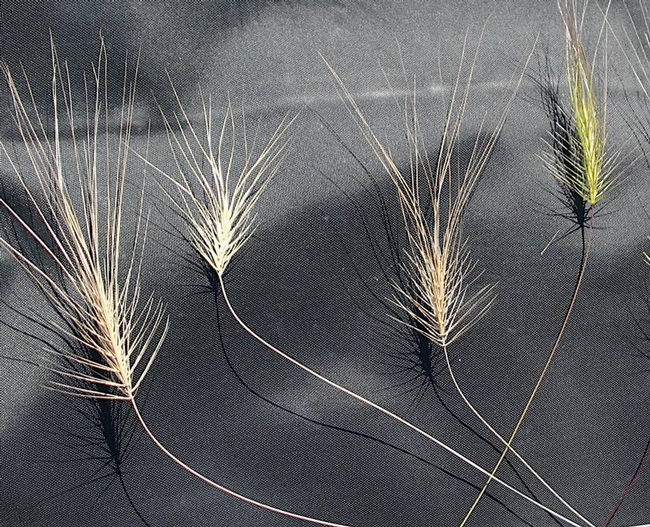Here's an article from the UCCE San Joaquin County Field Notes newsletter (May 2013.)

Controlled Burn. Fire is the best option for controlling medusahead. Since it is a late-season grass, our desirable grasses have already set seed and the seeds are on the surface of the ground, ready to germinate in the fall, while medusahead is still actively growing and green. A quick moving grass fire can control medusahead while not harming the seeds that have already dropped. Timing for a controlled burn typically should be early to mid-May, after the desirable grasses have started to turn brown and drop seeds and while Medusahead is still green and has not dropped seeds. Obtaining burn permits may be difficult.
Targeted Grazing. Medusahead has a short window of opportunity where grazing can have an impact. Typically in our area that window falls from April 15th to May 1st and corresponds to the period in development just before seed heads emerge. After the seed heads emerge, livestock typically will not graze it. Management practices that can increase animal concentration in areas with high medusahead can all work. We have created small pastures where we can increase the stocking density to 0.8 AUM/acre (an AUM is a 1000 lb. animal for a month), effectively creating pressure so all plants are grazed equally. Using 125lb supplement tubs, we created localized concentration areas and saw an effect up to about a 50-yard radius out from the supplement tub. Using this method, the supplement tub would have to be moved from one patch of medusahead to the next to see large-scale results.
Herbicide. Since Roundup is non-selective, we used it at three different timing levels to find a combination where we can allow for the longest grazing period and still control medusahead. Our late spring (early April) timing accomplished this. Recently Milestone has been used early in the year to selectively control medusahead and broadleaves, especially yellow starthistle. Timing is early fall and the higher the rate of Milestone applied, the better control was found to be, with roughly 89% control at 14 oz./acre compared to 59% control at 7 oz./acre. The label states “Spot treatments may be applied at an equivalent broadcast rate of up to 0.22 lb. acid equivalent (14 fl oz. of Milestone) per acre per annual growing season; however, not more than 50% of an acre may be treated at that rate.” So in addition to the cost of treatment, the label does not allow more than small patches to be treated at this high rate annually.
Mechanical. Mowing is another option and will allow for a three week window of opportunity, a week longer than grazing. We had success mowing plots in the Dunnigan Hills area and saw a substantial decrease in medusahead along with an increase in filaree, rose clover and annual ryegrass, desirable forages. Before mowing consider the amount and size of rocks in the area.
Fertilizer. One of our more recent projects has been to look at how nitrogen fertilization can change forage composition. In a drought year, fertilization resulted in a roughly 50% decrease in medusahead while annual ryegrass and bur clover increased. This year, we have added to the project, with a fall and spring treatment timing as well as two different rates of nitrogen. Results are promising so far that we should see a decrease in medusahead in the spring-fertilized plots, regardless of rate. These plots are grazed, and the reduction is due in part to competition since more desirable forages are using up the soil moisture, and by attracting livestock to the fertilized area. We are analyzing the percent crude protein between all of the plots. Our thought is that the extra nitrogen is increasing the crude protein in all of the forages and making medusahead more palatable at the critical period of grazing, right before it develops a seed head.
If you have medusahead on your ranch, especially if you find a new infestation, it is important to try a management practice that can help you reduce it and hopefully eradicate it before it becomes well established.